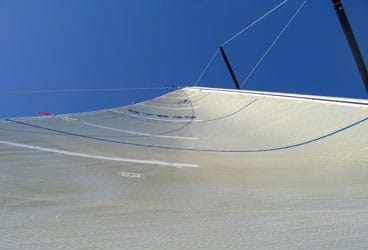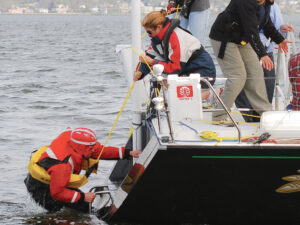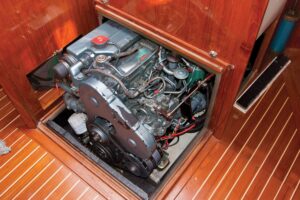
main sail 368
While cruising in Maine with my daughter, Kristi, we made a game out of trimming the sails so the boat would sail itself. It was great fun seeing who could set the boat up so no steering was necessary for the longest period of time. We also had a friend on board who was new to sailing. Our game turned into a lesson on trimming sails, and in the process we relearned that trimming can be great fun.
The mainsail on every sailboat is a versatile partner that should be used at all times while under way. On most modern boats, a second or third sail is usually set along with the main, but the latter is occasionally used alone. No matter the arrangement, it’s important that the main be trimmed properly. In general, correctly trimmed sails help the boat to sail faster and stay in balance and make the boat safer to be aboard. Proper trim also helps to preserve the sailcloth, keep the crew engaged, and even provides shade on a sunny day.
Before you start trimming, make sure that all lines, blocks, the traveler, fittings, and the mast and boom are in good working order. Any flaw in the system can cause a problem. A periodic check is worth the effort. I replace my sheets every two years.
The basic theory of trimming is simple: In light wind, a curved sail with lots of shape is faster, but as the wind speed increases, the sail needs to be flattened to reduce its power. To make trimming easy, I use indicators to help me get the best shape. My favorite indicators are telltales, the angle of heel of the boat, and the position of the draft on the sail.
A series of telltales along the leech of the main should flow evenly. If the top telltale stalls and curls around the back of the sail, the sail is trimmed too tightly. Another helpful indicator is to position yourself so you can sight up the sail, from below the boom, and line up the top batten with the boom. If the batten hooks to windward, the sail is trimmed in too hard. If the batten appears to fall off to leeward, the sail isn’t trimmed in tight enough.
Draft refers to the curvature or fullness of a sail. The maximum draft should be positioned about half of the way aft in the sail. When you take tension on a sail, the draft moves in that direction: If you want to sail closer to the wind, trim the sail in to move the center of draft aft. For more speed, ease the mainsail out, which moves the draft forward.
Small adjustments are important. A leech that’s flapping is inefficient and destroys the sail fabric. Keep the leech held tight by adjusting the sail’s leech line. And if your boat has one, make sure that the topping lift is well eased. The weight of the boom and sheet should be on the sail, not on the topping lift.
Most boats benefit from a boom vang, which keeps tension on the mainsail’s leech. In strong wind, be careful not to overtrim the vang; there’ll be no forgiveness in the sail, and the boat could spin out of control. The boom vang is most effective when sailing downwind to keep the sail and boom from flopping randomly, which can be dangerous.
If the wind picks up while you’re sailing closehauled and the boat starts to heel over, making it difficult to handle and uncomfortable for the crew, it’s time to depower the mainsail.
As the breeze builds, here are the steps that I’d suggest taking to depower the main, in the order that I follow on my boat: First, flatten the sail by tightening the outhaul and downhaul. Next, if your boat has an adjuster, tighten the backstay to put a slight bend in the mast; this makes the mast conform to the curve of the sail, which flattens the sail. Next, I’d suggest dropping the traveler to leeward to reduce the pressure on the main. The amount of pressure on the helm and rudder-weather helm-is a good indicator of a properly adjusted traveler. Boats tend to sail most efficiently when there are 3 to 5 degrees of windward helm applied.
You can also ease the sail to twist the top of the leech to leeward; this relieves pressure and reduces heeling. And finally, take a reef in the sail to reduce the amount of area. If you do take in a reef, it’s important to take your time and secure the sail carefully. Make sure the reef points gathering up the excess sail are tied with a reef knot that’s easily undone. Tie a reef knot, also called a square knot, so that one finished end is a bow that can be untied quickly.
With good care, mainsails can last several years. When not in use, keep the cover on to minimize sun damage. Fold the sail neatly, check for chafe, and wash it occasionally with fresh water.
Using these basic trimming techniques will provide comfortable, efficient, and fun cruising on boats of all sizes.
Backwind TIP
• Closehauled, a jib will sometimes backwind the mainsail, causing it to luff along the leading edge. This is normal; if there’s 1 to 2 feet of backwind, your trim is likely fine. If there’s a lot of backwind, the jib may be overpowered; try moving the jib-sheet lead aft or outboard. You can also try rolling in a portion of the jib.
Gary Jobson, a CW editor at large, is a sailing commentator on ESPN, a former America’s Cup racer, a frequent cruiser, and the president of U.S. Sailing.








